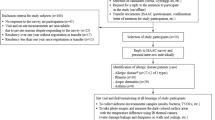Abstract
To assess the occurrence of respiratory and other symptoms among workers in relation to dampness in day-care centers, a random sample of 30 day-care centers in the city of Espoo, Finland, was selected for the study. The study population consisted of 268 female day-care workers, who filled in a questionnaire. Dampness was found to be common: water damage had taken place in 70% of the centers, and workers perceived mold odor in 17% of them. Adjusted risk of work-related eye and respiratory symptoms was in general higher among the day-care workers exposed to both water damage and mold odor than among the unexposed. The prevalence of eye symptoms was statistically significantly higher. The results provide new evidence of the importance of dampness and mold problems in the work environment as determinants of respiratory and irritative symptoms.
Similar content being viewed by others
References
Andrae S, Axelson O, Björksten B, Fredriksson M, Kjellman N-I (1988) Symptoms of bronchial hyperreactivity and asthma in relation to environmental factors. Arch Dis Child 63:473–478.
Brunekreef B (1992a) Associations between questionnaire reports of home dampness and childhood respiratory symptoms. Sci Tot Environ 127:79–89.
Brunekreef B (1992b) Damp housing and adult respiratory symptoms. Allergy 47:498–502.
Brunekreef B, Dockery DW, Speizer FE, Ware JH, Spengler JD, Ferris BG (1989) Home dampness and respiratory morbidity in children. Am Rev Respir Dis 140:1363–1367.
Burr ML, St Leger AS, Yarnell JWG (1981) Wheezing, dampness and coal fires. Commun Med 3:205–209.
Dales RE, Burnett R, Zwanenburg H (1991a) Adverse health effects among adults exposed to home dampness and molds. Am Rev Respir Dis 143:505–509.
Dales RE, Zwanenburg H, Burnett R, Franklin CA (1991b) Respiratory health effects of home dampness and molds among Canadian children. Am J Epidemiol 134:196–203.
Ferris BG Jr (1978) Epidemiology standardization project. Am Rev Respir Dis 118:1–120.
Hosmer DW, Lemeshow S (1989) Applied logistic regression. John Wiley, New York.
Hyndman SJ (1990) Housing dampness and health amongst British Bengalis in East London. Soc Sci Med 30:131–141.
Hyvärinen A, Reponen T, Husman T, Ruuskanen J, Nevalainen A (1993) Characterizing mold problem buildings — concentrations and flora of viable fungi. Indoor Air 3:337–343.
Jaakkola JJK, Jaakkola N, Ruotsalainen R (1993) Home dampness and molds as determinants of respiratory symptoms and asthma in pre-school children. J Expos Anal Environ Epidemiol 3:129–142
Martin CJ, Platt SD, Hunt SJ (1987) Housing conditions and ill health. Br Med J 294:1125–1127.
Miettinen OS (1985) Theoretical epidemiology. Principles of occurrence research. John Wiley, New York
NAWH (National Research and Development Center for Welfare and Health) (1990) Statistics of social and health care (in Finnish)
Platt SD, Martin CJ, Hunt SM, Lewis CW (1989) Damp housing, mould growth, and symptomatic health state. Br Med J 298:1673–1678.
Ruotsalainen R, Jaakkola N, Jaakkola JJK (1993) Ventilation and indoor air quality in Finnish daycare centers. Environ Int 19:109–119.
Strachan DP (1988) Damp housing and childhood asthma: validation of reporting of symptoms. Br Med J 297:1223–1226.
Strachan DP, Sanders CH (1989) Damp housing and childhood asthma; respiratory effects of indoor air temperature and relative humidity. J Epidemiol Community Health 43:7–14.
Strachan DP, Flannigan B, McCabe EM, McGarry F (1990) Quantification of airborne moulds in the homes of children with and without wheeze. Thorax 45:382–387.
Waegemaekers M, Van Wageningen N, Brunekreef B, Boleij JSM (1989) Respiratory symptoms in damp homes. Allergy 44:192–198.
Author information
Authors and Affiliations
Rights and permissions
About this article
Cite this article
Ruotsalainen, R., Jaakkola, N. & Jaakkola, J.J.K. Dampness and molds in day-care centers as an occupational health problem. Int. Arch Occup Environ Heath 66, 369–374 (1995). https://doi.org/10.1007/BF00383142
Received:
Accepted:
Issue Date:
DOI: https://doi.org/10.1007/BF00383142




